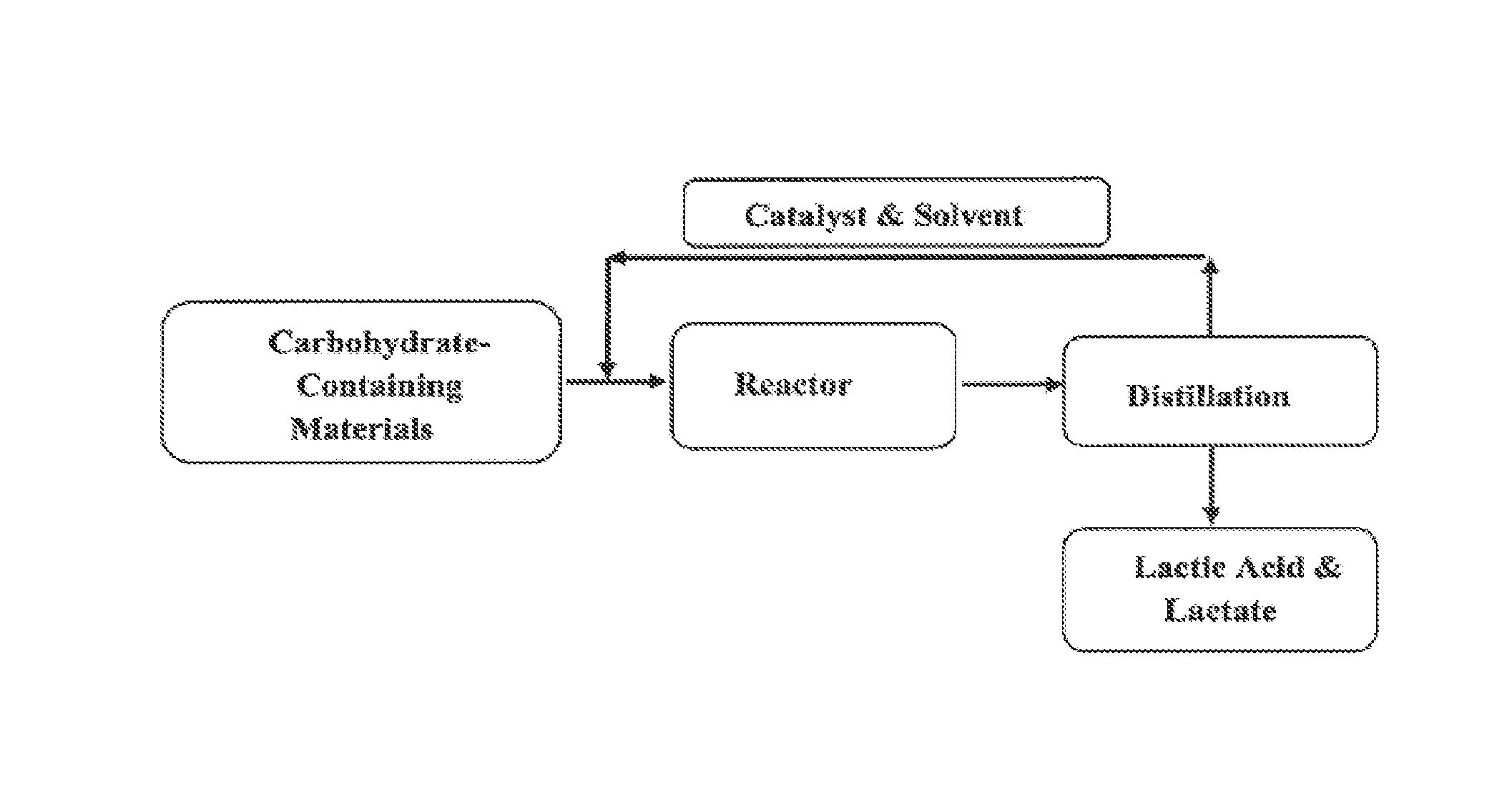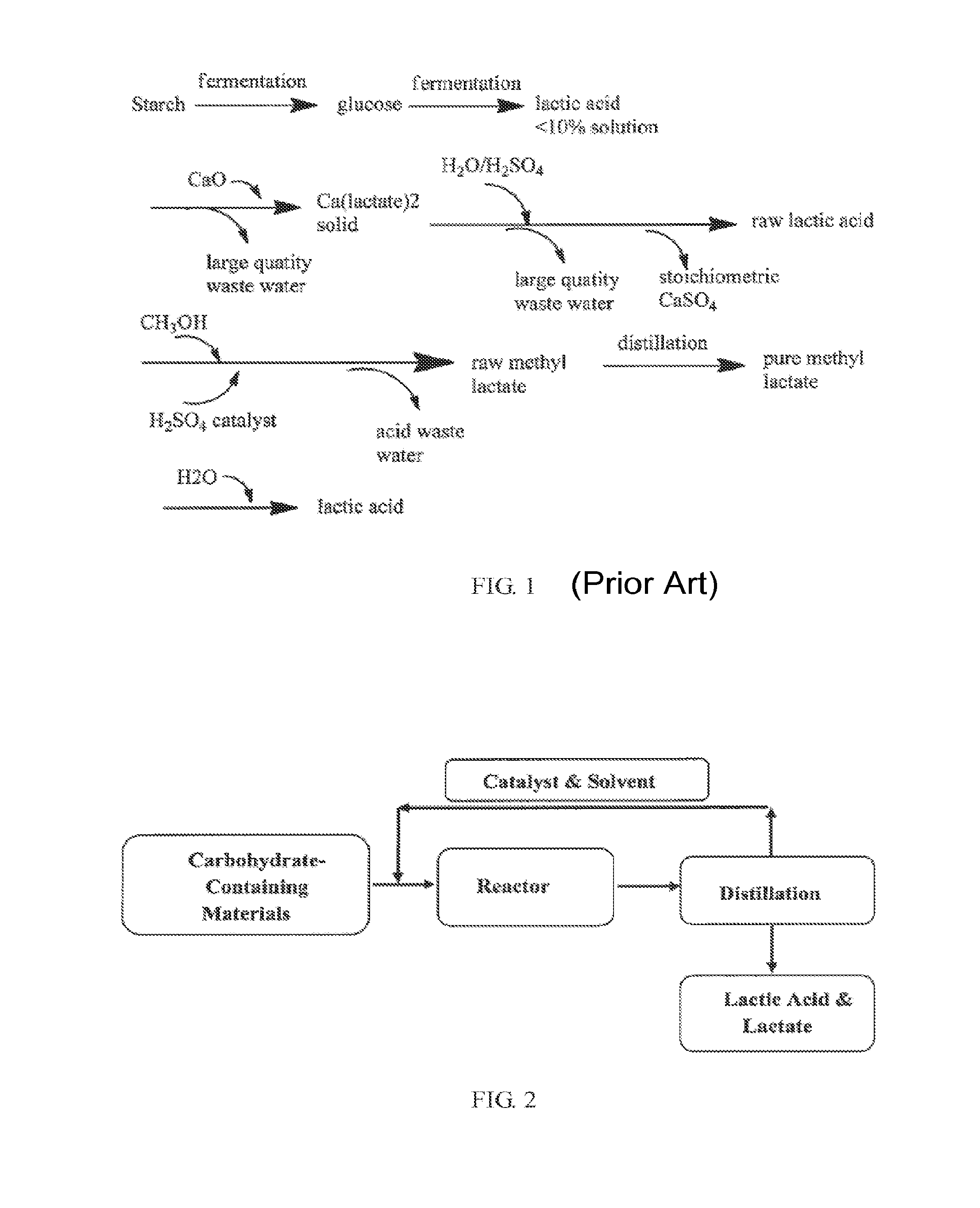Synthesis of Lactic Acid and Alkyl Lactate from Carbohydrate-Containing Materials
a technology of lactic acid and alkyl lactate, which is applied in the preparation of carbohydrate compounds, organic chemistry, chemistry apparatus and processes, etc., can solve the problems of large amount of waste water and caso generated by the fermentation process, low reaction rate, and low product concentration, and achieve the effect of effective use of carbohydrate-containing raw materials
- Summary
- Abstract
- Description
- Claims
- Application Information
AI Technical Summary
Benefits of technology
Problems solved by technology
Method used
Image
Examples
example 1
Reaction Results of Fructose
[0036]The results listed in Table 1 were obtained using 1,3-dimethylimidazolium methylsulfate and SnCl4.5H2O as catalyst. After adding 1,3-dimethylimidazolium methylsulfate (see the amount in Table 1), SnCl4.5H2O (see the amount in Table 1), 0.200 g of fructose, and 5.0 mL of methanol into a 10 mL batch reactor, the reactor was sealed and heated to 140° C. under stirring to carry out the reaction. The reaction time is listed in Table 1. After reaction, NaOH solution (0.50M, 10.0 mL) was added to carry out a hydrolysis reaction at 60° C. for 5 hours to obtain a solution. HCl solution (0.50M, 10.0 mL) was added into the resulting solution to convert sodium lactate to lactic acid, and then the solution was analyzed on a HPLC to obtain the total percent yield of lactic acid and methyl lactate (as that listed in Table 1). In Table 1, “DMIMMS” stands for the 1,3-dimethylimidazolium methylsulfate; “t” stands for reaction time in hours; “T” stands for the reactio...
example 2
Reaction Results of Glucose
[0037]The results listed in Table 2 were obtained using 1,3-dimethylimidazolium methylsulfate and SnCl4.5H2O as catalyst. After adding 1,3-dimethylimidazolium methylsulfate (see the amount in Table 2), SnCl4.5H2O (see the amount in Table 2), 0.200 g of glucose, and 5.0 mL of methanol into a 10 mL batch reactor, the reactor was sealed and heated to 140° C. under stirring to carry out the reaction. The reaction time is listed in Table 2. After reaction, NaOH solution (0.50M, 10.0 mL) was added to carry out a hydrolysis reaction at 60° C. for 5 hours to obtain a solution. HCl solution (0.50M, 10.0 mL) was added into the resulting solution to convert sodium lactate to lactic acid, and then the solution was analyzed on a HPLC to obtain the total percent yield of lactic acid and methyl lactate (as that listed in Table 2). In Table 2, “DMIMMS” stands for the 1,3-dimethylimidazolium methylsulfate; “t” stands for reaction time in hours; “T” stands for the reaction ...
example 3
Reaction Results of Sucrose
[0038]The results listed in Table 3 were obtained using different 1,3-dialkyl imidazolium salts and SnCl4.5H2O as catalyst. After adding 1,3-dialkyl imidazolium salt (see the amount in Table 3), SnCl4.5H2O (see the amount in Table 3), 0.200 g of sucrose, and 5.0 mL of methanol into a 10 mL batch reactor, the reactor was sealed and heated to reaction temperature (listed in Table 3) under stirring to carry out the reaction. The reaction time is listed in Table 3. After reaction, NaOH solution (0.50 M, 10.0 mL) was added to carry out a hydrolysis reaction at 60° C. for 5 hours to obtain a solution. HCl solution (0.50 M, 10.0 mL) was added into the resulted solution to convert sodium lactate to lactic acid. The solution was analyzed on a HPLC to obtain the total percent yield of lactic acid and methyl lactate (as that listed in Table 3). In Table 3, “t” stands for reaction time in hours; “T” stands for the reaction temperature in degrees Celsius; and “Y” stand...
PUM
| Property | Measurement | Unit |
|---|---|---|
| temperature | aaaaa | aaaaa |
| temperature | aaaaa | aaaaa |
| temperature | aaaaa | aaaaa |
Abstract
Description
Claims
Application Information
 Login to View More
Login to View More - R&D
- Intellectual Property
- Life Sciences
- Materials
- Tech Scout
- Unparalleled Data Quality
- Higher Quality Content
- 60% Fewer Hallucinations
Browse by: Latest US Patents, China's latest patents, Technical Efficacy Thesaurus, Application Domain, Technology Topic, Popular Technical Reports.
© 2025 PatSnap. All rights reserved.Legal|Privacy policy|Modern Slavery Act Transparency Statement|Sitemap|About US| Contact US: help@patsnap.com



